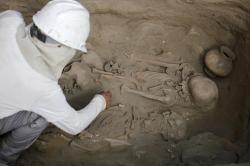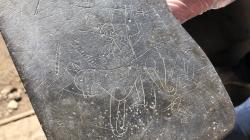INSTITUT SUPERIEUR D'ANTHROPOLOGIE
INSTITUTE OF ANTHROPOLOGY
ONLINE COURSES / COURS A DISTANCE
SPRING TERM : APRIL 2018
REGISTER NOW
PEROU –  Trujillo - Archaeologists in Peru have unearthed the remains of at least 12 children believed to have been sacrificed by the ancient Chimú civilisation, Reuters has reported. The team also uncovered a hoard of more than 100 treasures in the Trujillo region, where 47 tombs have been found. Victor Campos, director at the archaeological site, said the children were found with cuts to their chest area, Reuters reported. These cuts, researchers believe, may have been an attempt to break the ribs of the children—possibly to remove their hearts. The sacrifice of humans was relatively common in pre-Columbian societies, Reuters reported. These new discoveries clarify ancient Chimú practices. Campos thinks the civilization may have performed sacrifices to encourage the gods to bring rain to this arid region of Peru. “What they (Chimú) wanted to do with the presence of the children in this arid area is to attract rain, to improve cultivation,” he said.
Trujillo - Archaeologists in Peru have unearthed the remains of at least 12 children believed to have been sacrificed by the ancient Chimú civilisation, Reuters has reported. The team also uncovered a hoard of more than 100 treasures in the Trujillo region, where 47 tombs have been found. Victor Campos, director at the archaeological site, said the children were found with cuts to their chest area, Reuters reported. These cuts, researchers believe, may have been an attempt to break the ribs of the children—possibly to remove their hearts. The sacrifice of humans was relatively common in pre-Columbian societies, Reuters reported. These new discoveries clarify ancient Chimú practices. Campos thinks the civilization may have performed sacrifices to encourage the gods to bring rain to this arid region of Peru. “What they (Chimú) wanted to do with the presence of the children in this arid area is to attract rain, to improve cultivation,” he said.
http://www.newsweek.com/child-sacrifice-ancient-peru-chimu-archaeology-856529
IRLANDE –  Dublin - Archaeologists have discovered a 12th-century medieval terrace while excavating a hotel site in Dublin. The remains of nine post-and-wattle structures from the 12th century were found in a dig at Dean Street in the Coombe.The archaeologists have described the discovery as “incredibly significant”. As well as the post-and-wattle structures, a variety of artefacts have also been discovered, including a well-preserved drawing on slate that shows a man riding a horse. Also discovered was medieval pottery, a 13th century silver coin and part of a bronze weighing scales. The five dwellings and four outhouses were located outside the ancient city walls of Dublin.
Dublin - Archaeologists have discovered a 12th-century medieval terrace while excavating a hotel site in Dublin. The remains of nine post-and-wattle structures from the 12th century were found in a dig at Dean Street in the Coombe.The archaeologists have described the discovery as “incredibly significant”. As well as the post-and-wattle structures, a variety of artefacts have also been discovered, including a well-preserved drawing on slate that shows a man riding a horse. Also discovered was medieval pottery, a 13th century silver coin and part of a bronze weighing scales. The five dwellings and four outhouses were located outside the ancient city walls of Dublin.
https://www.rte.ie/news/ireland/2018/0322/949233-coombe-medieval/
INDE –  Goa - A senior official working with Mormugao Port Trust (MPT) found a rare 300-400 years old sati stone with a pictorial representation of the ancient system of sati. MPT officer Captain Manoj Joshi found the stone while taking stroll at a nearby unoccupied bungalow at Headland Sada in Mormugao. “This stone must be minimum 300 to 400 years old and has lot of archaeological significance to reconstruct our own cultural past. As per procedure we have taken possession of the stone and have informed the office district collector as well as local police and we are shifting the same to our head office. Very soon it will be in a museum for public to see along with the information of sculpture,” Sabnis said. As per history books the sati stone, with pictorial representation and inscription or without inscription, is not only a very rare find but having very important records for understanding the social and cultural milieu of the period. The sculptures on these sati stones usually depict the husband and wife and sometimes the event in which her husband lost his life. A few even graphically portray the event such as a fierce fight which led to death of the hero and the depiction of lady with wifely devotion. Some of these stones bear inscriptions explaining the event and also the name of sati and her husband’s name and title of the family. Based on the alphabets of the inscriptions, it also enables to date the period when the sati stone was installed.
Goa - A senior official working with Mormugao Port Trust (MPT) found a rare 300-400 years old sati stone with a pictorial representation of the ancient system of sati. MPT officer Captain Manoj Joshi found the stone while taking stroll at a nearby unoccupied bungalow at Headland Sada in Mormugao. “This stone must be minimum 300 to 400 years old and has lot of archaeological significance to reconstruct our own cultural past. As per procedure we have taken possession of the stone and have informed the office district collector as well as local police and we are shifting the same to our head office. Very soon it will be in a museum for public to see along with the information of sculpture,” Sabnis said. As per history books the sati stone, with pictorial representation and inscription or without inscription, is not only a very rare find but having very important records for understanding the social and cultural milieu of the period. The sculptures on these sati stones usually depict the husband and wife and sometimes the event in which her husband lost his life. A few even graphically portray the event such as a fierce fight which led to death of the hero and the depiction of lady with wifely devotion. Some of these stones bear inscriptions explaining the event and also the name of sati and her husband’s name and title of the family. Based on the alphabets of the inscriptions, it also enables to date the period when the sati stone was installed.
https://www.heraldgoa.in/Goa-News/300yearold-sati-stone-discovered-/128482.html